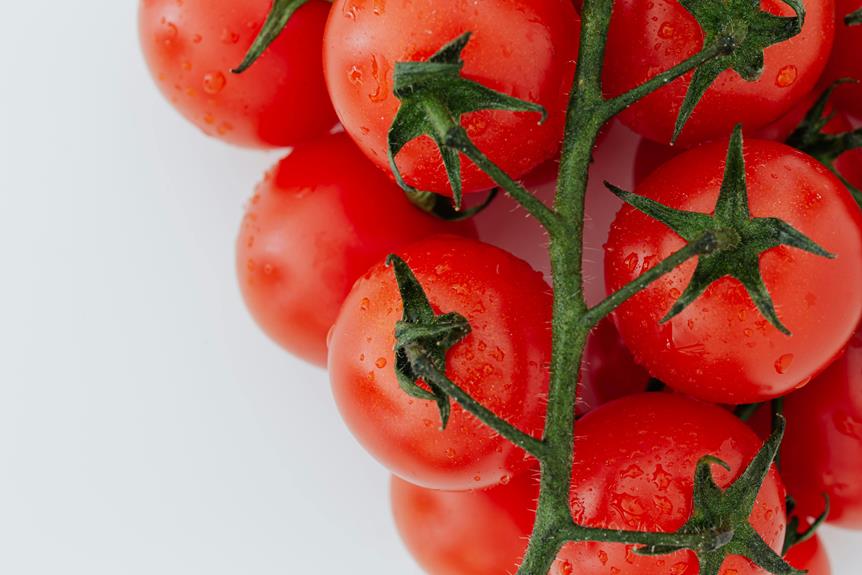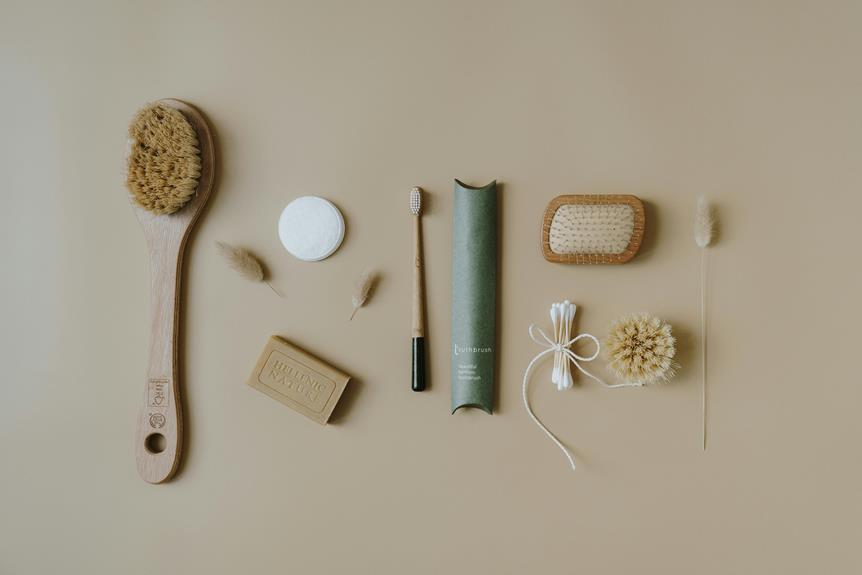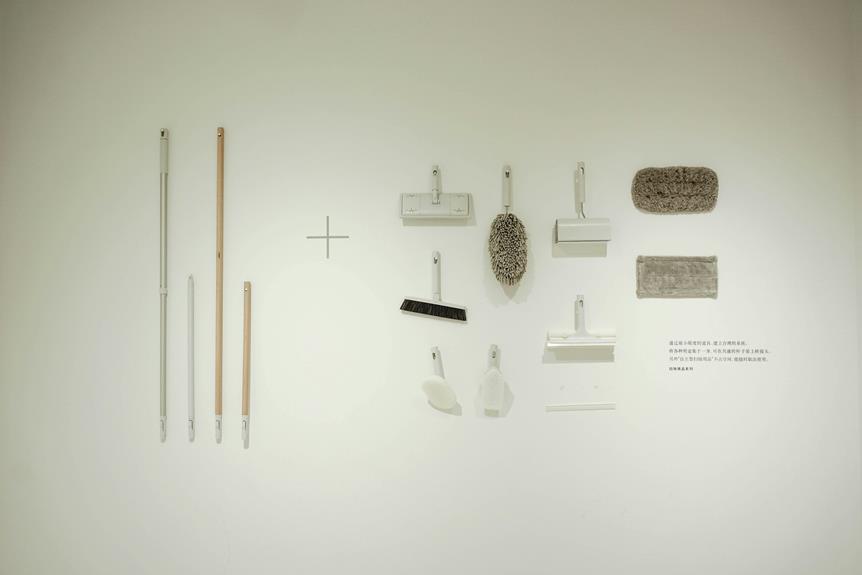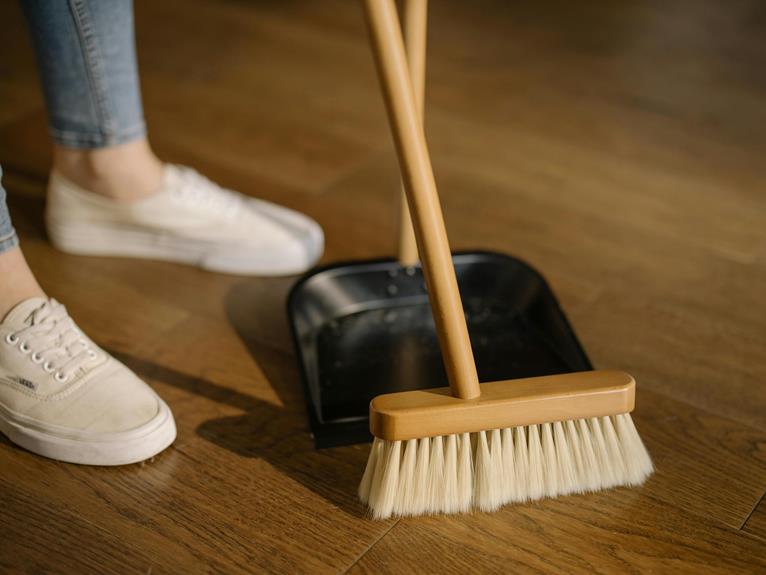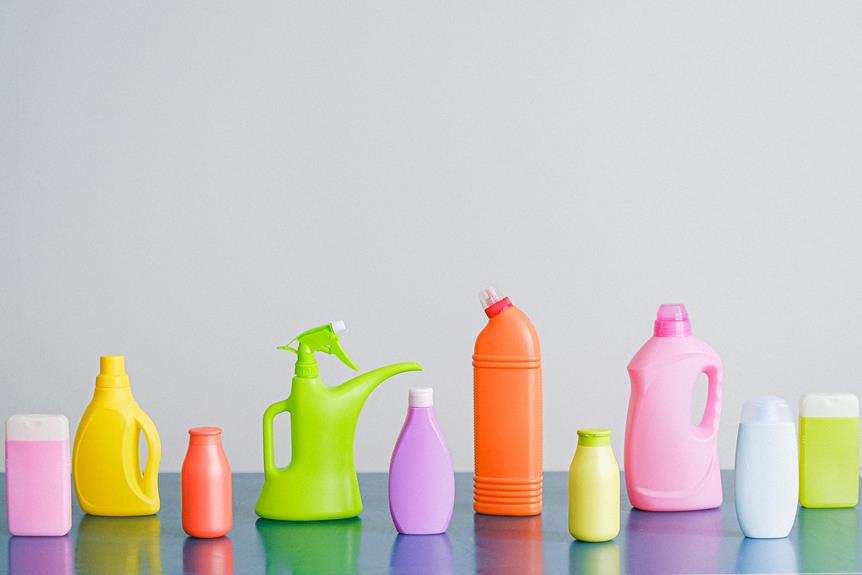As the seasons change, so do the cleaning needs of your kitchen. Seasonal cleaning for a sparkling kitchen goes beyond the usual wipe-downs and spot cleanings and involves a thorough and systematic approach to maintaining a pristine cooking and dining area.
From addressing hidden grease and grime to decluttering and reorganizing, seasonal cleaning ensures that your kitchen remains a place of culinary inspiration and cleanliness.
By incorporating seasonal cleaning practices, you can elevate the functionality and aesthetics of your kitchen while promoting a healthy environment for food preparation and enjoyment.
Clearing Out the Clutter
It’s time to declutter your kitchen and create a more organized and efficient space. A clutter-free kitchen not only brings a sense of calm and order but also makes cooking and meal prep much easier.
Start by organizing your utensils. Separate them into categories like cooking utensils, baking tools, and serving spoons. This makes it easier to find what you need when you need it.
Declutter your countertops. Remove any unnecessary items and only keep the essentials within reach. This creates more workspace and makes cleaning easier.
Rearrange your shelves to maximize storage and accessibility. Group similar items together and place them in clear containers or labeled bins. This makes it easier to find and put away items, reducing clutter.
Don’t forget to sort through your spices. Get rid of any expired or unused spices and organize them in a way that makes it easy to see what you have.
Lastly, purge your pantry and refrigerator of expired or spoiled food. This creates more space and ensures you’re only keeping fresh and usable ingredients.

Deep Cleaning the Oven
If you want to deep clean your oven, start by taking out the racks and removing any loose debris. This will make it easier to reach all the nooks and crannies. Once the oven is clear, you can focus on getting rid of grease and burnt residue.
Make a paste by mixing baking soda and water. Apply this paste to the inside of your oven, paying extra attention to areas with stubborn grease and burnt residue. Let it sit for a few hours or overnight to work its magic.
After the paste has sat for a while, use a damp cloth or sponge to wipe away the loosened grease and residue. For hard-to-reach spots, you can use a toothbrush or a small scrub brush to gently scrub away any remaining buildup.
To get rid of any lingering odors, place a bowl of vinegar or lemon juice inside the oven and heat it at a low temperature. This will help eliminate any unpleasant smells that may have built up over time.
Refreshing the Refrigerator
If you want to give your refrigerator a fresh start, start by emptying it. It’s time to refresh your fridge and make it feel like new again. Begin by removing all the food, condiments, and other items stored inside. Once everything is out, it’s time to get to work.
Freshen up the fridge shelves. Wipe them down with a mild cleaner and a damp cloth to remove any spills or stains. This won’t only make your fridge look cleaner, but it will also help eliminate any lingering odors.
Organize your condiments. Group similar items together and place them in a designated area of the fridge. This will make it easier to find what you need and ensure proper storage.
Don’t forget to defrost the freezer. Over time, ice can build up and affect the efficiency of your freezer. Remove everything and allow the ice to melt naturally. Once melted, wipe down the inside with a mixture of water and vinegar to remove any lingering odors.
While you’re at it, clean the door handles. These can easily become dirty and germy, so give them a good wipe-down with a disinfectant cleaner. This will help keep your fridge clean and hygienic.
Finally, take the time to remove any food stains from the inside of your fridge. Use a mild cleaner and a cloth to gently scrub away any marks or spills. This will leave your fridge looking fresh and inviting.
Reviving the Stovetop
To bring your stovetop back to its shining glory, start by removing the grates and burner caps. This will allow you to clean every nook and cranny thoroughly. Follow these three essential steps to revive your stovetop:
- Remove Grease: Grease buildup on your stovetop not only looks unsightly but can also affect performance. Cut through the grease using a degreaser or a mixture of dish soap and warm water. Gently scrub with a sponge or soft brush to avoid scratching the surface.
- Restore Shine: After removing the grease, it’s time to restore the shine. Wipe down the stovetop with a microfiber cloth or paper towel. For stubborn stains or burnt-on food, make a paste using baking soda and water. Apply the paste to the affected area, let it sit for a few minutes, then scrub gently and wipe clean.
- Clean Grates and Eliminate Stains: Don’t forget to clean the grates and burner caps as well. Soak them in warm, soapy water to loosen any stuck-on food or stains. Use a scrub brush or toothbrush to remove any remaining residue. Rinse thoroughly and dry before placing them back on the stovetop.
Scrubbing the Sink
Now that you’ve brought your stovetop back to its shining glory, it’s time to tackle the next task: scrubbing the sink. A clean and sparkling sink is essential for maintaining a well-kept kitchen. To help you achieve this, here are some effective scrubbing techniques and eco-friendly cleaners that will make your sink shine.
Scrubbing Techniques:
- Gently scrub the sink using a soft sponge or cloth.
- Use a vinegar and water solution by mixing equal parts vinegar and water in a spray bottle. Spray the solution onto the sink and let it sit for a few minutes before scrubbing.
- Create a paste by mixing baking soda with water. Apply the paste to the sink and scrub with a sponge or cloth.
- For a natural solution, cut a lemon in half and rub it directly onto the sink. The lemon’s natural acidity will help remove stains and leave a fresh scent.
Preventing Sink Stains:
- Avoid leaving dirty dishes in the sink for extended periods. Rinse and wash them promptly.
Removing Stubborn Grime:
- For stubborn grime, make a mixture of baking soda and vinegar. Apply the paste to the grime, let it sit for a few minutes, and scrub with a brush.
Maintaining a Shiny Sink:
- To keep your sink shiny, regularly wipe it down with a microfiber cloth and mild dish soap. Avoid using abrasive cleaners or scrub brushes that can scratch the surface.
Polishing the Countertops
It’s time to give your countertops a shiny finish that will make them gleam. Follow these simple steps to polish your countertops and keep them looking their best:
- Use the right products: When choosing a polishing product, make sure it’s designed for your countertop material. Different materials need different care, so read the label and choose a suitable product.
- Try natural cleaners: If you prefer natural cleaners, you have several options. Mix vinegar and water to create a simple and effective cleaner for many types of countertops. Baking soda and lemon juice can also remove stains and restore the shine.
- Prevent stains: To maintain the shine of your countertops, it’s important to prevent stains from setting in. Clean up spills immediately and avoid leaving acidic or colored substances on the surface for too long. Use cutting boards and trivets to protect the countertop from scratches and heat damage.
Cleaning the Cabinets and Drawers
To start cleaning your cabinets and drawers, begin by emptying them. This will allow you to thoroughly clean every surface and give your kitchen a fresh start. The first step is to wipe down the shelves, removing any dust or debris that may have accumulated. This not only makes your cabinets look cleaner but also helps to protect your dishes and cookware.
Once the shelves are clean, it’s time to organize your utensils. Take this opportunity to declutter and get rid of any items you no longer use or need. By organizing your utensils, you’ll be able to easily find what you need when cooking, making your time in the kitchen more efficient and enjoyable.
Next, wipe down all the surfaces inside the cabinets and drawers, removing any grease or grime that may have built up over time. This not only improves the appearance of your cabinets but also helps to prevent the spread of bacteria, creating a clean and healthy kitchen environment.
Lastly, don’t forget to disinfect the handles of your cabinets and drawers. These areas are often overlooked but can harbor germs and bacteria. .
Dusting and Organizing the Pantry
To continue your seasonal kitchen cleaning, start by dusting and organizing your pantry for a fresh and efficient cooking space. Your pantry holds all your essential ingredients and supplies, so it’s important to keep it tidy. Let’s break it down into three simple steps:
- Rearrange your containers: Take a look at your pantry shelves and see if there’s a better way to arrange your containers. Group similar items together, like canned goods, baking supplies, and snacks. This will make it easier to find what you need and prevent items from getting lost in the back.
- Label your shelves: Stay organized by labeling your shelves. Use sticky labels or chalkboard labels to mark where each type of item belongs. This will make it easier for you and your family members to find things and put them back in the right spot.
- Maximize your space: Decluttering is key to maximizing space in your pantry. Go through your pantry and get rid of any expired or unused items. Consider using storage containers or baskets to keep smaller items organized and make the most of your shelf space. By decluttering and using storage solutions, you’ll have more room for all your pantry essentials.
With these steps, you’ll have a clean and organized pantry that makes cooking a breeze.
Washing the Windows and Blinds
For a clean kitchen, make sure to thoroughly wash your windows and blinds. Keeping the blinds clean and removing grime from the windows is essential for maintaining a fresh and inviting kitchen.
Start by dusting the blinds with a microfiber cloth or feather duster to remove any loose dirt or debris. Then, choose the right cleaning solution for your windows. A mixture of warm water and mild dish soap usually does the trick. Avoid using harsh chemicals that can damage the blinds or leave streaks on the windows.
When cleaning the blinds, gently wipe them down using a soft cloth or sponge. Remember to clean both sides of each blind for a thorough clean.
To avoid streaks on your windows, use a squeegee or a lint-free cloth. Start from the top and work your way down, wiping away any excess moisture as you go.
Finally, use proper drying techniques to prevent water spots. You can gently dry the windows and blinds using a microfiber cloth or a clean, lint-free towel.
These tips will leave your windows and blinds sparkling clean, bringing brightness to your kitchen.
Sanitizing Small Appliances
Keeping your small kitchen appliances clean and germ-free is essential for maintaining cleanliness and ensuring hygienic food preparation. Here are three important tasks you can do to achieve this:
- Sanitizing the coffee maker: Regularly cleaning and sanitizing your coffee maker is crucial to prevent the buildup of mold and bacteria. Start by removing any leftover coffee grounds and rinsing the pot and filter basket with warm, soapy water. Then, fill the water reservoir with a mixture of equal parts water and vinegar and run a brewing cycle. Finally, run two cycles of plain water to ensure all vinegar residue is removed.
- Disinfecting the toaster: Toasters can harbor crumbs and bacteria, so it’s important to clean and disinfect them regularly. Begin by unplugging the toaster and removing the crumb tray. Empty and clean the tray using warm, soapy water. Use a soft brush or toothbrush to gently clean the inside of the toaster, ensuring all remaining crumbs are removed. Wipe the exterior with a damp cloth and a disinfecting cleaner.
- Cleaning blender blades: After each use, it’s crucial to thoroughly clean the blender blades. Disassemble the blender and rinse the jar with warm, soapy water. Wipe the base and control panel with a damp cloth. If there’s any stubborn residue, you can blend a mixture of warm water and dish soap for a few seconds to remove it effectively.
Disinfecting the Cutting Boards
Maintaining a clean and sanitary kitchen is important, and regularly disinfecting your cutting boards is a crucial step. By disinfecting your cutting boards, you not only keep them clean but also prevent cross-contamination and ensure the safety of your family and guests.
Follow these best practices and use natural cleaning solutions to effectively disinfect your cutting boards.
Start by washing your cutting board with hot, soapy water after each use. This will remove any leftover food particles and residue. Rinse the board thoroughly to ensure all soap is removed.
To disinfect the cutting board, you can create a solution using equal parts water and white vinegar, or a mixture of water and hydrogen peroxide. Simply spray or pour the solution onto the cutting board and let it sit for a few minutes before wiping it clean.
Another natural way to disinfect is by using a lemon half, salt, or baking soda. These ingredients have antibacterial properties that can help eliminate germs.
Proper maintenance and storage of your cutting boards is also important. Avoid using abrasive cleaners or harsh chemicals as they can damage the board’s surface. Instead, opt for a food-safe mineral oil to moisturize and protect the board.
When storing the cutting board, make sure it’s completely dry to prevent bacteria growth. Store it in a cool, dry place away from direct sunlight.
Cleaning the Microwave
When it’s time to clean your microwave, there are a few simple steps you can follow to make it sparkle again. Let’s get started!
Step 1: Cleaning the microwave filters
Start by removing the filters from your microwave. These filters can get clogged with grease and dirt, which can affect the performance of your microwave. To clean them, soak them in warm soapy water, gently scrub them, and rinse them thoroughly. Make sure to let them dry completely before putting them back in the microwave.
Step 2: Removing stubborn stains
If you have stubborn stains in your microwave, try using a natural cleaning solution. Mix equal parts vinegar and water in a microwave-safe bowl and heat it for a few minutes until it starts to steam. Be careful when removing the bowl, as it will be hot. Then, use a damp cloth to wipe down the interior of the microwave. The steam will help loosen the stains, making them easier to wipe off.
Step 3: Preventing odors with steam cleaning
To keep your microwave smelling fresh, try the steam cleaning method. Fill a microwave-safe bowl with water and add a few slices of lemon or a tablespoon of baking soda. Microwave it for a couple of minutes until the water starts to boil and steam. The steam will help eliminate any lingering odors, leaving your microwave smelling clean and inviting.
Restoring the Dishwasher’s Shine
If you want to restore your dishwasher’s shine, start by giving it a thorough cleaning inside and out. This won’t only make it look better, but it will also improve its performance.
Begin by taking out the racks and utensil holders and soaking them in warm soapy water. Use a sponge or brush to scrub away any tough stains.
Then, wipe down the inside of the dishwasher with a mixture of vinegar and water to get rid of any residue or buildup. Pay special attention to the spray arms and filters, as they can easily get clogged and affect the water flow.
Rinse everything well and put the racks and utensil holders back in place. To prevent future buildup, run a cycle with a dishwasher cleaner or a cup of vinegar on the top rack. This will help improve the water flow and keep your dishwasher hygienic.
Tackling Hard-To-Reach Spots
Now that your dishwasher’s shine has been restored, let’s focus on those hard-to-reach areas that may still need some cleaning. Don’t worry, with a little effort, you can make your kitchen sparkle from top to bottom. Here are three tips to help you tackle those tricky spots:
- Reaching High: Dust and grime can accumulate on top of cabinets and shelves, so it’s important to clean those high areas. Grab a sturdy step stool or ladder and use a long-handled duster or microfiber cloth to wipe away the dust. Be cautious and maintain your balance while reaching for those high spots.
- Under Appliances: Over time, crumbs, spills, and grease can find their way under appliances, creating a breeding ground for bacteria. Use a vacuum cleaner with a narrow attachment or a long, flexible brush to clean under your refrigerator, stove, and other appliances. It’s a small effort that will make a big difference in keeping your kitchen clean and hygienic.
- Tight Corners and Hidden Crevices: Dirt and debris tend to accumulate in tight corners and hidden crevices, making them tricky to clean. To tackle these areas, use a toothbrush or a small, soft-bristle brush along with a mixture of warm water and dish soap. Gently scrub the corners and crevices to remove any buildup, ensuring your kitchen is spotless from every angle.
Don’t forget about the top shelves! Dust and grime can accumulate there too. Take a few extra minutes to wipe down these areas, and you’ll have a kitchen that shines from floor to ceiling.
Finishing Touches and Final Touches
Now it’s time to add the final touches to your kitchen for a truly sparkling space. These small details can make a big difference in the overall look and feel of your kitchen.
Start by paying attention to your kitchen decor. Add a pop of color with vibrant dish towels or a decorative fruit bowl. Hang up artwork or family photos to personalize the space and create a warm and inviting atmosphere.
Next, focus on organizing tips to keep your kitchen tidy and clutter-free. Use storage containers or baskets to corral loose items like utensils or spices. Label shelves and drawers to stay organized and find what you need quickly. Declutter your countertops by storing away unnecessary appliances or knick-knacks.
Don’t forget the importance of cleaning supplies. Make sure you have all the necessary tools to maintain your sparkling kitchen. Stock up on cleaning products, including disinfectant wipes, glass cleaner, and stainless steel polish. Having these supplies readily available will make it easier to quickly clean up any spills or messes, keeping your kitchen fresh and inviting.
Conclusion
Implementing seasonal cleaning routines for the kitchen can also contribute to a healthier living environment by reducing the buildup of dirt, grime, and potential allergens.
This can help to create a more enjoyable and stress-free cooking experience while promoting a sense of cleanliness and well-being in the home.

